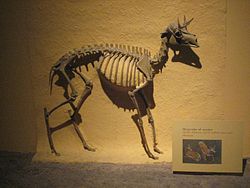| Merycodontinae | |
|---|---|
 | |
| Merycodus | |
| Scientific classification | |
| Kingdom: | Animalia |
| Phylum: | Chordata |
| Class: | Mammalia |
| Order: | Artiodactyla |
| Family: | Antilocapridae |
| Subfamily: | † Merycodontinae |
| Genera | |
Merycondontinae is a subfamily of pronghorn that arose during the middle of the Miocene and became extinct by the end of that period.

The Merycondontinae were small, slightly built, fast-running ungulates. Both males and females were horned.
The genera Meryceros and Submeryceros are generally regarded as synonymous with Merycodus . [1] [2]